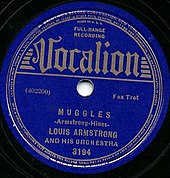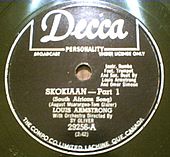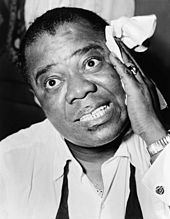Louis Armstrong
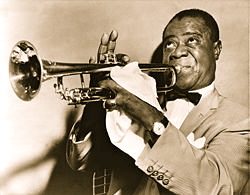
Louis Armstrong & His All Stars Live In Berlin 1965
Louis Armstrong & His All Stars. Live in Berlin 1965. Musicians:
LOUIS ARMSTRONG – vocals, trumpet, JEWEL BROWN – vocals (7, 8, 17, 18), TYREE GLENN – trombone, EDDIE SHU – clarinet, BILLY KYLE – piano, ARVELL SHAW – bass and DANNY BARCELONA – drums.
Track List:
1. When It’s Sleepy Time Down South
2. Indiana
3. Black And Blue
4. When I Grow Too Old To Dream
5. Hello Dolly
6. Memories Of You
7. Lover, Come Back To Me
8. Can’t Help loving That Man
9. When The Saint Go Marchin’ In
10. Struttin’ With Some Barbecue
11. The Faithful Hussar
12. Royal Garden Blues
13. Blueberry Hill
14. Without A Song
15. How High The Moon
16. Mack The Knife
17. I Left My Heart In San Francisco
18. My Man
19. Mop Mop
20. When It’s Sleppy Time Down South
21. Hello Dolly
 Louis Armstrong (August 4, 1901 – July 6, 1971), nicknamed Satchmo or Pops, was an American jazz trumpeter and singer from New Orleans, Louisiana.
Louis Armstrong (August 4, 1901 – July 6, 1971), nicknamed Satchmo or Pops, was an American jazz trumpeter and singer from New Orleans, Louisiana.
Coming to prominence in the 1920s as an “inventive” cornet and trumpet player, Armstrong was a foundational influence in jazz, shifting the focus of the music from collective improvisation to solo performance. With his instantly-recognizable gravelly voice, Armstrong was also an influential singer, demonstrating great dexterity as an improviser, bending the lyrics and melody of a song for expressive purposes. He was also greatly skilled at scat singing (vocalizing using sounds and syllables instead of actual lyrics).
Renowned for his charismatic stage presence and voice almost as much as for his trumpet-playing, Armstrong’s influence extends well beyond jazz music, and by the end of his career in the 1960s, he was widely regarded as a profound influence on popular music in general. Armstrong was one of the first truly popular African-American entertainers to “cross over”, whose skin-color was secondary to his music in an America that was severely racially divided. He rarely publicly politicized his race, often to the dismay of fellow African-Americans, but took a well-publicized stand for desegregation during the Little Rock Crisis. His artistry and personality allowed him socially acceptable access to the upper echelons of American society that were highly restricted for a black man.
Early life
 Handcolored etching Louis Armstrong by Adi Holzer 2002.
Handcolored etching Louis Armstrong by Adi Holzer 2002.
Armstrong often stated that he was born on July 4, 1900, a date that has been noted in many biographies. Although he died in 1971, it was not until the mid-1980s that his true birth date of August 4, 1901 was discovered by researcher Tad Jones through the examination of baptismal records. Armstrong was born into a very poor family in New Orleans, Louisiana, the grandson of slaves. He spent his youth in poverty, in a rough neighborhood of Uptown New Orleans, known as “Back of the Town”, as his father, William Armstrong (1881–1922), abandoned the family when Louis was an infant and took up with another woman. His mother, Mary “Mayann” Albert (1886–1942), then left Louis and his younger sister Beatrice Armstrong Collins (1903–1987) in the care of his grandmother, Josephine Armstrong, and at times, his Uncle Isaac. At five, he moved back to live with his mother and her relatives, and saw his father only in parades.
He attended the Fisk School for Boys, where he likely had early exposure to music. He brought in some money as a paperboy and also by finding discarded food and selling it to restaurants, but it was not enough to keep his mother from prostitution. He hung out in dance halls close to home, where he observed everything from licentious dancing to the quadrille. For extra money he also hauled coal to Storyville, the famed red-light district, and listened to the bands playing in the brothels and dance halls, especially Pete Lala’s where Joe “King” Oliver performed and other famous musicians would drop in to jam.
After dropping out of the Fisk School at age eleven, Armstrong joined a quartet of boys who sang in the streets for money. But he also started to get into trouble. Cornet player Bunk Johnson said he taught Armstrong (then 11) to play by ear at Dago Tony’s Tonk in New Orleans, although in his later years Armstrong gave the credit to Oliver. Armstrong hardly looked back at his youth as the worst of times but instead drew inspiration from it, “Every time I close my eyes blowing that trumpet of mine—I look right in the heart of good old New Orleans… It has given me something to live for.”
He also worked for a Lithuanian-Jewish immigrant family, the Karnofskys, who had a junk hauling business and gave him odd jobs. They took him in and treated him as almost a family member, knowing he lived without a father, and would feed and nurture him. He later wrote a memoir of his relationship with the Karnofskys titled, Louis Armstrong + the Jewish Family in New Orleans, La., the Year of 1907. In it he describes his discovery that this family was also subject to discrimination by “other white folks’ nationalities who felt that they were better than the Jewish race… I was only seven years old but I could easily see the ungodly treatment that the White Folks were handing the poor Jewish family whom I worked for.” Armstrong wore a Star of David pendant for the rest of his life and wrote about what he learned from them: “how to live—real life and determination.” The influence of Karnofsky is remembered in New Orleans by the Karnofsky Project, a non-profit organization dedicated to accepting donated musical instruments to “put them into the hands of an eager child who could not otherwise take part in a wonderful learning experience.”
 Armstrong with his first trumpet instructor, Peter Davis, in 1965.
Armstrong with his first trumpet instructor, Peter Davis, in 1965.
Armstrong developed his cornet playing seriously in the band of the New Orleans Home for Colored Waifs, where he had been sent multiple times for general delinquency, most notably for a long term after firing his stepfather’s pistol into the air at a New Year’s Eve celebration, as police records confirm. Professor Peter Davis (who frequently appeared at the Home at the request of its administrator, Captain Joseph Jones) instilled discipline in and provided musical training to the otherwise self-taught Armstrong. Eventually, Davis made Armstrong the band leader. The Home band played around New Orleans and the thirteen-year-old Louis began to draw attention by his cornet playing, starting him on a musical career. At fourteen he was released from the Home, living again with his father and new stepmother and then back with his mother and also back to the streets and their temptations. Armstrong got his first dance hall job at Henry Ponce’s where Black Benny became his protector and guide. He hauled coal by day and played his cornet at night.
He played in the city’s frequent brass band parades and listened to older musicians every chance he got, learning from Bunk Johnson, Buddy Petit, Kid Ory, and above all, Joe “King” Oliver, who acted as a mentor and father figure to the young musician. Later, he played in the brass bands and riverboats of New Orleans, and began traveling with the well-regarded band of Fate Marable, which toured on a steamboat up and down the Mississippi River. He described his time with Marable as, “going to the University,” since it gave him a much wider experience working with written arrangements.
In 1919, Joe Oliver decided to go north and resigned his position in Kid Ory‘s band; Armstrong replaced him. He also became second trumpet for the Tuxedo Brass Band, a society band.
Career
“Muggles“
“Skokiaan“
“Heebie Jeebies” by Louis Armstrong and his Hot Five
On March 19, 1918, Louis married Daisy Parker from Gretna, Louisiana. They adopted a 3-year-old boy, Clarence Armstrong, whose mother, Louis’ cousin Flora, died soon after giving birth. Clarence Armstrong was mentally disabled (the result of a head injury at an early age) and Louis would spend the rest of his life taking care of him. Louis’ marriage to Parker failed quickly and they separated. She died shortly after the divorce.
Through all his riverboat experience Armstrong’s musicianship began to mature and expand. At twenty, he could read music and he started to be featured in extended trumpet solos, one of the first jazzmen to do this, injecting his own personality and style into his solo turns. He had learned how to create a unique sound and also started using singing and patter in his performances. In 1922, Armstrong joined the exodus to Chicago, where he had been invited by his mentor, Joe “King” Oliver, to join his Creole Jazz Band and where he could make a sufficient income so that he no longer needed to supplement his music with day labor jobs. It was a boom time in Chicago and though race relations were poor, the “Windy City” was teeming with jobs for black people, who were making good wages in factories and had plenty to spend on entertainment.
Oliver’s band was the best and most influential hot jazz band in Chicago in the early 1920s, at a time when Chicago was the center of the jazz universe. Armstrong lived like a king in Chicago, in his own apartment with his own private bath (his first). Excited as he was to be in Chicago, he began his career-long pastime of writing nostalgic letters to friends in New Orleans. As Armstrong’s reputation grew, he was challenged to “cutting contests” by hornmen trying to displace the new phenom, who could blow two hundred high C’s in a row. Armstrong made his first recordings on the Gennett and Okeh labels (jazz records were starting to boom across the country), including taking some solos and breaks, while playing second cornet in Oliver’s band in 1923. At this time, he met Hoagy Carmichael (with whom he would collaborate later) who was introduced by friend Bix Beiderbecke, who now had his own Chicago band.
Armstrong enjoyed working with Oliver, but Louis’ second wife, pianist Lil Hardin Armstrong, urged him to seek more prominent billing and develop his newer style away from the influence of Oliver. Armstrong took the advice of his wife and left Oliver’s band. For a year Armstrong played in Fletcher Henderson‘s band in New York on many recordings. After playing in New York, Armstrong returned to Chicago, playing in large orchestras; there he created his most important early recordings. Lil had her husband play classical music in church concerts to broaden his skill and improve his solo play and she prodded him into wearing more stylish attire to make him look sharp and to better offset his growing girth. Lil’s influence eventually undermined Armstrong’s relationship with his mentor, especially concerning his salary and additional moneys that Oliver held back from Armstrong and other band members. Armstrong and Oliver parted amicably in 1924. Shortly afterward, Armstrong received an invitation to go to New York City to play with the Fletcher Henderson Orchestra, the top African-American band of the day. Armstrong switched to the trumpet to blend in better with the other musicians in his section. His influence upon Henderson’s tenor saxsoloist, Coleman Hawkins, can be judged by listening to the records made by the band during this period.
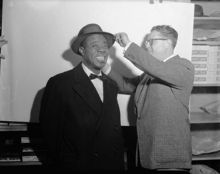 Armstrong getting fitted for a hat, about 1955.
Armstrong getting fitted for a hat, about 1955.
Armstrong quickly adapted to the more tightly controlled style of Henderson, playing trumpet and even experimenting with the trombone and the other members quickly took up Armstrong’s emotional, expressive pulse. Soon his act included singing and telling tales of New Orleans characters, especially preachers. The Henderson Orchestra was playing in the best venues for white-only patrons, including the famed Roseland Ballroom, featuring the classy arrangements of Don Redman. Duke Ellington’s orchestra would go to Roseland to catch Armstrong’s performances and young hornmen around town tried in vain to outplay him, splitting their lips in their attempts.
During this time, Armstrong made many recordings on the side, arranged by an old friend from New Orleans, pianist Clarence Williams; these included small jazz band sides with the Williams Blue Five (some of the best pairing Armstrong with one of Armstrong’s few rivals in fiery technique and ideas, Sidney Bechet) and a series of accompaniments with blues singers, including Bessie Smith, Ma Rainey, and Alberta Hunter.
Armstrong returned to Chicago in 1925 due mostly to the urging of his wife, who wanted to pump up Armstrong’s career and income. He was content in New York but later would concede that she was right and that the Henderson Orchestra was limiting his artistic growth. In publicity, much to his chagrin, she billed him as “the World’s Greatest Trumpet Player”. At first, he was actually a member of the Lil Hardin Armstrong Band and working for his wife. He began recording under his own name for Okeh with his famous Hot Five and Hot Seven groups, producing hits such as “Potato Head Blues“, “Muggles“, (a reference to marijuana, for which Armstrong had a lifelong fondness), and “West End Blues“, the music of which set the standard and the agenda for jazz for many years to come.
The group included Kid Ory (trombone), Johnny Dodds (clarinet), Johnny St. Cyr (banjo), wife Lil on piano, and usually no drummer. Armstrong’s bandleading style was easygoing, as St. Cyr noted, “One felt so relaxed working with him, and he was very broad-minded . . . always did his best to feature each individual.” His recordings soon after with pianist Earl “Fatha” Hines (most famously their 1928 Weatherbird duet) and Armstrong’s trumpet introduction to “West End Blues” remain some of the most famous and influential improvisations in jazz history. Armstrong was now free to develop his personal style as he wished, which included a heavy dose of effervescent jive, such as “whip that thing, Miss Lil” and “Mr. Johnny Dodds, Aw, do that clarinet, boy!”
Armstrong also played with Erskine Tate’s Little Symphony, actually a quintet, which played mostly at the Vendome Theatre. They furnished music for silent movies and live shows, including jazz versions of classical music, such as “Madame Butterfly,” which gave Armstrong experience with longer forms of music and with hosting before a large audience. He began to scat sing (improvised vocal jazz using non-sensical words) and was among the first to record it, on “Heebie Jeebies” in 1926. The recording was so popular that the group became the most famous jazz band in the United States, even though they had not performed live to any great extent. Young musicians across the country, black or white, were turned on by Armstrong’s new type of jazz.
After separating from Lil, Armstrong started to play at the Sunset Café for Al Capone’s associate Joe Glaser in the Carroll DickersonOrchestra, with Earl Hines on piano, which was soon renamed Louis Armstrong and his Stompers, though Hines was the music director and Glaser managed the orchestra. Hines and Armstrong became fast friends as well as successful collaborators.
Armstrong returned to New York, in 1929, where he played in the pit orchestra of the successful musical Hot Chocolate, an all-black revue written by Andy Razaf and pianist/composer Fats Waller. He also made a cameo appearance as a vocalist, regularly stealing the show with his rendition of “Ain’t Misbehavin’“, his version of the song becoming his biggest selling record to date.
Armstrong started to work at Connie’s Inn in Harlem, chief rival to the Cotton Club, a venue for elaborately staged floor shows, and a front for gangster Dutch Schultz. Armstrong also had considerable success with vocal recordings, including versions of famous songs composed by his old friend Hoagy Carmichael. His 1930s recordings took full advantage of the new RCA ribbon microphone, introduced in 1931, which imparted a characteristic warmth to vocals and immediately became an intrinsic part of the ‘crooning‘ sound of artists like Bing Crosby. Armstrong’s famous interpretation of Hoagy Carmichael’s “Stardust” became one of the most successful versions of this song ever recorded, showcasing Armstrong’s unique vocal sound and style and his innovative approach to singing songs that had already become standards.
Armstrong’s radical re-working of Sidney Arodin and Carmichael’s “Lazy River” (recorded in 1931) encapsulated many features of his groundbreaking approach to melody and phrasing. The song begins with a brief trumpet solo, then the main melody is stated by sobbing horns, memorably punctuated by Armstrong’s growling interjections at the end of each bar: “Yeah! …”Uh-huh” …”Sure” … “Way down, way down.” In the first verse, he ignores the notated melody entirely and sings as if playing a trumpet solo, pitching most of the first line on a single note and using strongly syncopated phrasing. In the second stanza he breaks into an almost fully improvised melody, which then evolves into a classic passage of Armstrong “scat singing“.
As with his trumpet playing, Armstrong’s vocal innovations served as a foundation stone for the art of jazz vocal interpretation. The uniquely gritty coloration of his voice became a musical archetype that was much imitated and endlessly impersonated. His scat singing style was enriched by his matchless experience as a trumpet soloist. His resonant, velvety lower-register tone and bubbling cadences on sides such as “Lazy River” exerted a huge influence on younger white singers such as Bing Crosby.
The Depression of the early Thirties was especially hard on the jazz scene. The Cotton Club closed in 1936 after a long downward spiral, and many musicians stopped playing altogether as club dates evaporated. Bix Beiderbecke died and Fletcher Henderson’s band broke up. King Oliver made a few records but otherwise struggled. Sidney Bechet became a tailor and Kid Ory returned to New Orleans and raised chickens.
Armstrong moved to Los Angeles in 1930 to seek new opportunities. He played at the New Cotton Club in Los Angeles with Lionel Hampton on drums. The band drew the Hollywood crowd, which could still afford a lavish night life, while radio broadcasts from the club connected with younger audiences at home. Bing Crosby and many other celebrities were regulars at the club. In 1931, Armstrong appeared in his first movie, Ex-Flame. Armstrong was convicted of marijuana possession but received a suspended sentence. He returned to Chicago in late 1931 and played in bands more in the Guy Lombardo vein and he recorded more standards. When the mob insisted that he get out of town, Armstrong visited New Orleans, got a hero’s welcome and saw old friends. He sponsored a local baseball team known as “Armstrong’s Secret Nine” and got a cigar named after himself. But soon he was on the road again and after a tour across the country shadowed by the mob, Armstrong decided to go to Europe to escape.
After returning to the United States, he undertook several exhausting tours. His agent Johnny Collins’ erratic behavior and his own spending ways left Armstrong short of cash. Breach of contract violations plagued him. Finally, he hired Joe Glaser as his new manager, a tough mob-connected wheeler-dealer, who began to straighten out his legal mess, his mob troubles, and his debts. Armstrong also began to experience problems with his fingers and lips, which were aggravated by his unorthodox playing style. As a result he branched out, developing his vocal style and making his first theatrical appearances. He appeared in movies again, including Crosby’s 1936 hit Pennies from Heaven. In 1937, Armstrong substituted for Rudy Vallee on the CBS radio network and became the first African American to host a sponsored, national broadcast. He finally divorced Lil in 1938 and married longtime girlfriend Alpha.
After spending many years on the road, Armstrong settled permanently in Queens, New York in 1943 in contentment with his fourth wife, Lucille. Although subject to the vicissitudes of Tin Pan Alley and the gangster-ridden music business, as well as anti-black prejudice, he continued to develop his playing. He recorded Hoagy Carmichael’s Rockin’ Chair for Okeh Records.
During the subsequent thirty years, Armstrong played more than three hundred gigs a year. Bookings for big bands tapered off during the 1940s due to changes in public tastes: ballrooms closed, and there was competition from television and from other types of music becoming more popular than big band music. It became impossible under such circumstances to support and finance a 16-piece touring band.
The All Stars
Following a highly successful small-group jazz concert at New York Town Hall on May 17, 1947, featuring Armstrong with trombonist/singer Jack Teagarden, Armstrong’s manager Joe Glaser dissolved the Armstrong big band on August 13, 1947 and established a six-piece small group featuring Armstrong with (initially) Teagarden, Earl Hines and other top swing and dixieland musicians, most of them ex-big band leaders. The new group was announced at the opening of Billy Berg’s Supper Club.
This group was called Louis Armstrong and his All Stars and included at various times Earl “Fatha” Hines, Barney Bigard, Edmond Hall, Jack Teagarden, Trummy Young, Arvell Shaw, Billy Kyle, Marty Napoleon, Big Sid Catlett, Cozy Cole, Tyree Glenn, Barrett Deems, Joe Darensbourg and the Filipino-American percussionist, Danny Barcelona. During this period, Armstrong made many recordings and appeared in over thirty films. He was the first jazz musician to appear on the cover of Time Magazine on February 21, 1949.
In 1964, he recorded his biggest-selling record, “Hello, Dolly!” The song went to No. 1 on the pop chart, making Armstrong (age 63) the oldest person to ever accomplish that feat. In the process, Armstrong dislodged The Beatles from the No. 1 position they had occupied for 14 consecutive weeks with three different songs.
Armstrong kept up his busy tour schedule until a few years before his death in 1971. In his later years he would sometimes play some of his numerous gigs by rote, but other times would enliven the most mundane gig with his vigorous playing, often to the astonishment of his band. He also toured Africa, Europe, and Asia under sponsorship of the US State Department with great success, earning the nickname “Ambassador Satch.” While failing health restricted his schedule in his last years, within those limitations he continued playing until the day he died.
Death
Armstrong died of a heart attack in his sleep on July 6, 1971, a month before his 70th birthday, and 11 months after playing a famous show at the Waldorf-Astoria‘s Empire Room. He was residing in Corona, Queens, New York City, at the time of his death. He was interred in Flushing Cemetery, Flushing, in Queens, New York City. His honorary pallbearers included Bing Crosby, Ella Fitzgerald, Dizzy Gillespie, Pearl Bailey, Count Basie, Harry James, Frank Sinatra, Ed Sullivan, Earl Wilson, Alan King, Johnny Carson and David Frost. Peggy Lee sang The Lord’s Prayer at the services while Al Hibbler sang “Nobody Knows the Trouble I’ve Seen” and Fred Robbins, a long-time friend, gave the eulogy.

